Expanding malaria diagnosis and treatment in Lao PDR: lessons learned from a public-private mix initiative
- PMID: 29132370
- PMCID: PMC5683316
- DOI: 10.1186/s12936-017-2104-5
Expanding malaria diagnosis and treatment in Lao PDR: lessons learned from a public-private mix initiative
Abstract
Background: As in other countries of the Greater Mekong Sub-region (GMS), the private health sector constitutes a significant avenue where malaria services are provided and presents a unique opportunity for public-private collaboration. In September 2008, a public-private mix (PPM) strategy was launched initially in four northern and southern provinces in Lao PDR to increase access to rapid diagnostic tests (RDTs) and artemisinin-based combination therapy (ACT), improve quality of care, and collect routine malaria data from the private sector. Throughout the process, key stakeholders were involved in the planning, monitoring and supervision of project sites. Following an initial assessment in 2009, the PPM initiative expanded to an additional 14 district sites to a total of 245 private pharmacies and 16 clinics covering 8 provinces and 22 districts. By June 2016, a total of 317 pharmacies, 30 clinics in 32 districts of the 8 provinces were participating in the PPM network and reported monthly malaria case data.
Methods: This descriptive study documented the process of initiating and maintaining the PPM network in Lao PDR. Epidemiological data reported through the routine surveillance system from January 2009 to June 2016 were analyzed to illustrate the contribution of case reporting from the private sector.
Results: A total of 2,301,676 malaria tests were performed in the PPM districts, which included all the PPM pharmacies and clinics (176,224, 7.7%), proportion of patients tested from 14,102 (4.6%) in 2009 to 29,554 (10.4%) in 2015. Over the same period of 90 months, a total of 246,091 positive cases (10.7%) were detected in PPM pharmacies and clinics (33,565; 13.6%), in the same districts as the PPM sites. The results suggest that the PPM sites contributed to a significant increasing proportion of patients positive for malaria from 1687 (7.4%) in 2009 to 5697 (15.8%) in 2015.
Conclusions: Ensuring adequate and timely supplies of RDTs and ACT to PPM sites is critical. Frequent refresher training is necessary to maintain data quality, motivation and feedback. In the context of malaria elimination, the PPM initiative should be expanded further to ensure that all febrile cases seen through the private sector in malaria transmission areas are tested for malaria and treated appropriately. Results from the PPM must be integrated into a centralized registry of malaria cases that should prompt required case and foci investigations and responses to be conducted as part of elimination efforts.
Keywords: Lao PDR; Malaria diagnosis; Public–private mix; Treatment.
Figures
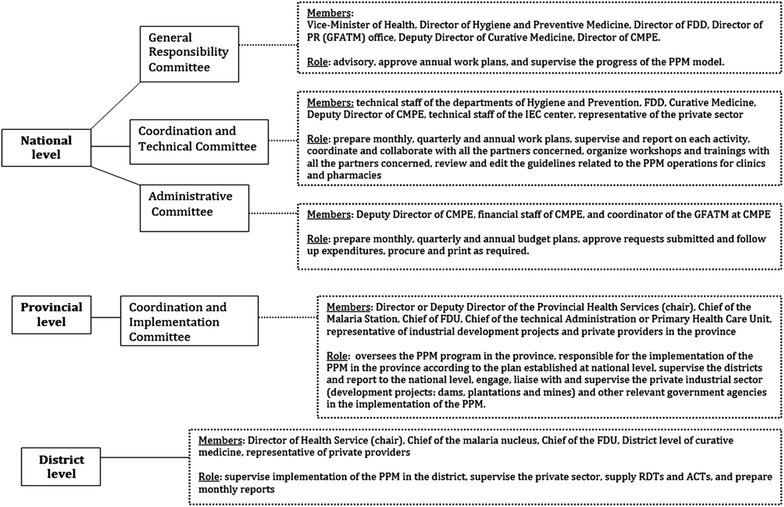
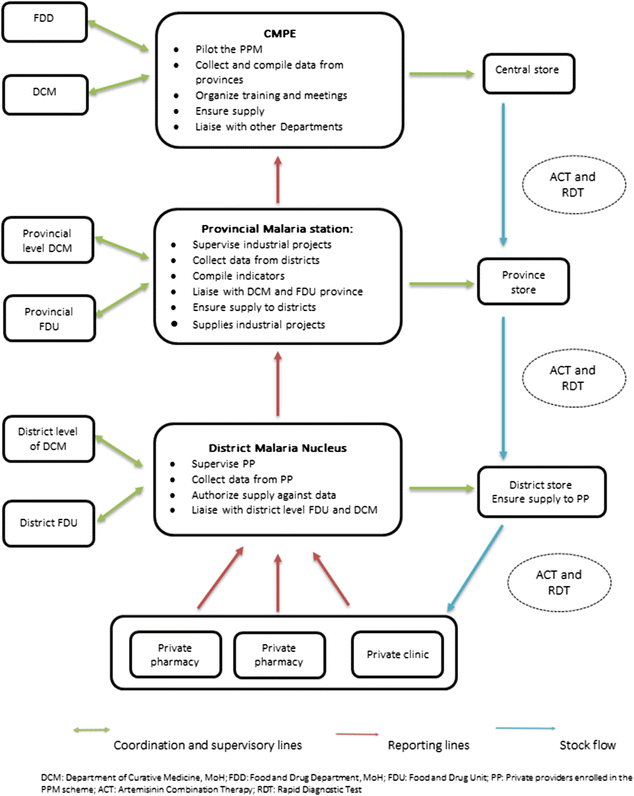
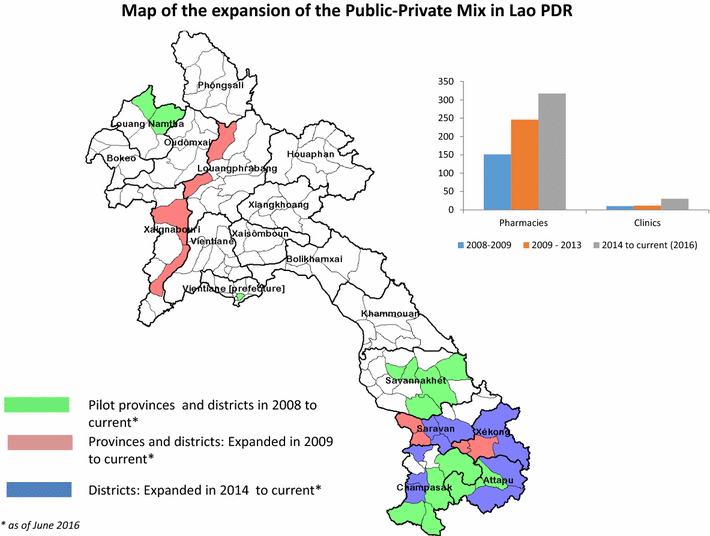

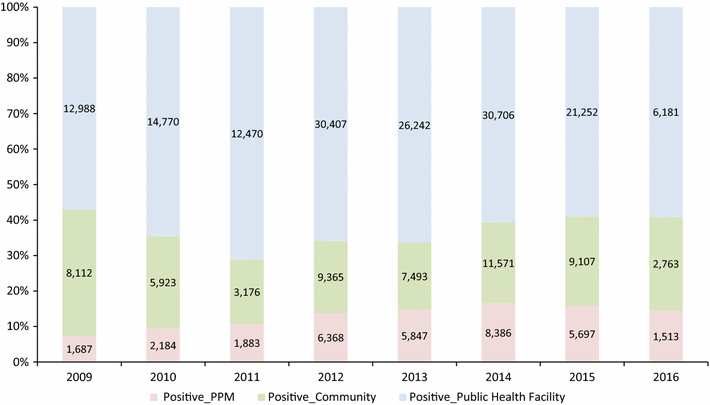
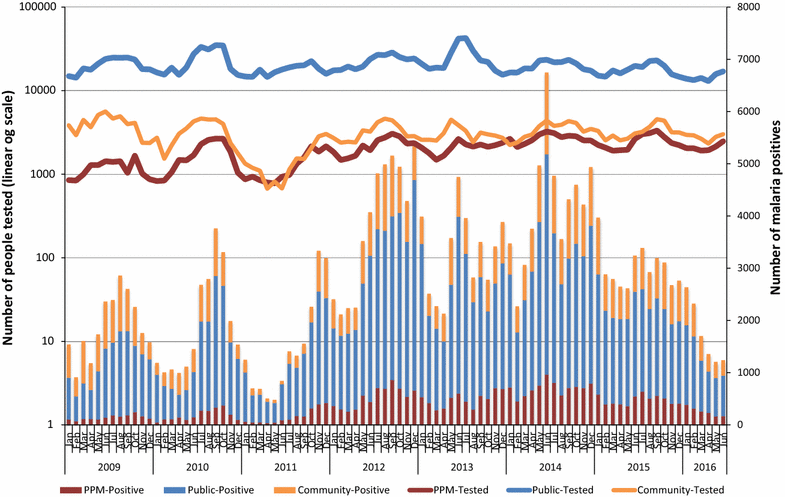
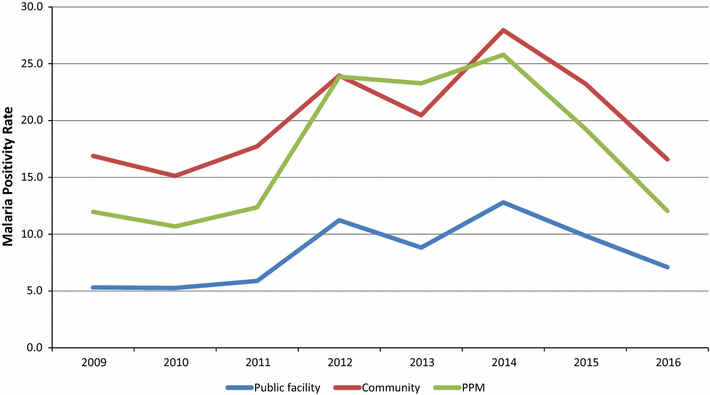
Similar articles
-
Private Sector Contributions to National Malaria Surveillance Systems in Elimination Settings: Lessons Learned from Cambodia, Lao PDR, Myanmar, and Vietnam.Am J Trop Med Hyg. 2022 Dec 19;108(2_Suppl):14-23. doi: 10.4269/ajtmh.22-0147. Print 2023 Feb 2. Am J Trop Med Hyg. 2022. PMID: 35914687 Free PMC article.
-
The malaria testing and treatment landscape in the southern Lao People's Democratic Republic (PDR).Malar J. 2017 Apr 25;16(1):169. doi: 10.1186/s12936-017-1769-0. Malar J. 2017. PMID: 28438155 Free PMC article.
-
Expanding access to parasite-based malaria diagnosis through retail drug shops in Tanzania: evidence from a randomized trial and implications for treatment.Malar J. 2017 Jan 3;16(1):6. doi: 10.1186/s12936-016-1658-y. Malar J. 2017. PMID: 28049481 Free PMC article. Clinical Trial.
-
Private sector opportunities and threats to achieving malaria elimination in the Greater Mekong Subregion: results from malaria outlet surveys in Cambodia, the Lao PDR, Myanmar, and Thailand.Malar J. 2017 May 2;16(1):180. doi: 10.1186/s12936-017-1800-5. Malar J. 2017. PMID: 28464945 Free PMC article. Review.
-
Folic acid supplementation and malaria susceptibility and severity among people taking antifolate antimalarial drugs in endemic areas.Cochrane Database Syst Rev. 2022 Feb 1;2(2022):CD014217. doi: 10.1002/14651858.CD014217. Cochrane Database Syst Rev. 2022. PMID: 36321557 Free PMC article.
Cited by
-
India could harness public-private partnerships to achieve malaria elimination.Lancet Reg Health Southeast Asia. 2022 Sep 12;5:100059. doi: 10.1016/j.lansea.2022.100059. eCollection 2022 Oct. Lancet Reg Health Southeast Asia. 2022. PMID: 37383669 Free PMC article. Review.
-
Malaria outbreak in Laos driven by a selective sweep for Plasmodium falciparum kelch13 R539T mutants: a genetic epidemiology analysis.Lancet Infect Dis. 2023 May;23(5):568-577. doi: 10.1016/S1473-3099(22)00697-1. Epub 2022 Nov 30. Lancet Infect Dis. 2023. PMID: 36462526 Free PMC article.
-
Cost-effectiveness analysis of G6PD diagnostic test for Plasmodium vivax radical cure in Lao PDR: An economic modelling study.PLoS One. 2022 Apr 25;17(4):e0267193. doi: 10.1371/journal.pone.0267193. eCollection 2022. PLoS One. 2022. PMID: 35468145 Free PMC article.
-
Private Sector Contributions to National Malaria Surveillance Systems in Elimination Settings: Lessons Learned from Cambodia, Lao PDR, Myanmar, and Vietnam.Am J Trop Med Hyg. 2022 Dec 19;108(2_Suppl):14-23. doi: 10.4269/ajtmh.22-0147. Print 2023 Feb 2. Am J Trop Med Hyg. 2022. PMID: 35914687 Free PMC article.
-
Deforestation inhibits malaria transmission in Lao PDR: a spatial epidemiology using Earth observation satellites.Trop Med Health. 2023 Nov 2;51(1):60. doi: 10.1186/s41182-023-00554-4. Trop Med Health. 2023. PMID: 37915065 Free PMC article.
References
MeSH terms
Substances
Grants and funding
LinkOut - more resources
Full Text Sources
Other Literature Sources
Medical
Research Materials

